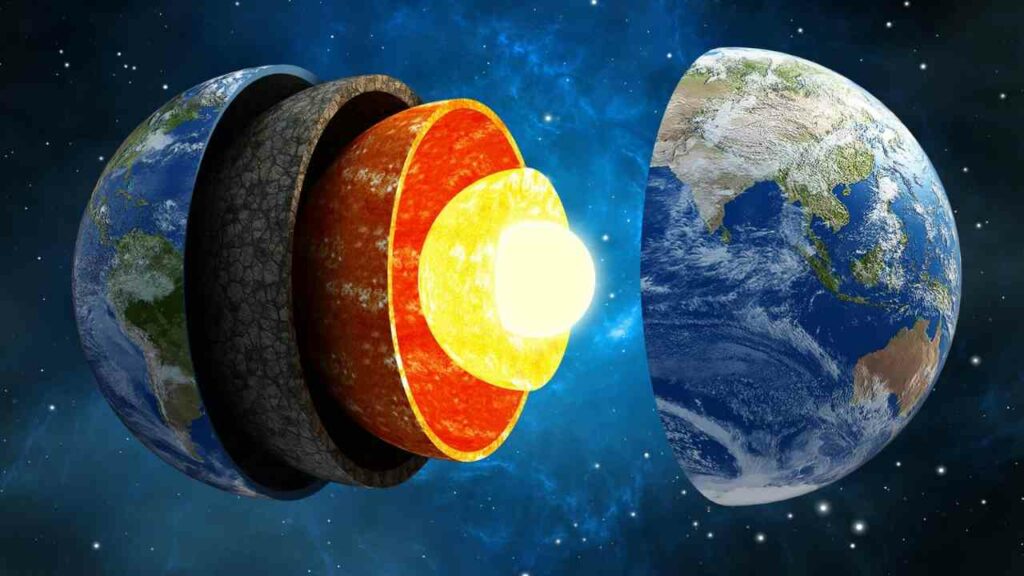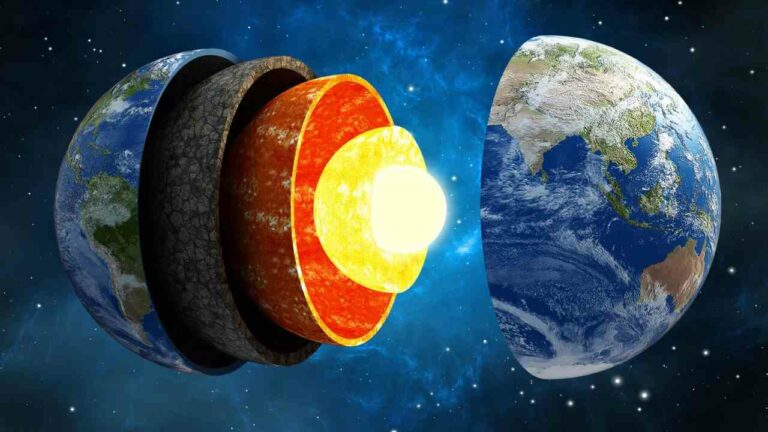A recent study proposes that the Earth’s core experiences an enigmatic wobble approximately every 8.5 years.
The Earth’s core, a complex and vital component of our planet, consists of two distinct parts: a fluid, partly molten outer core and a predominantly solid inner core. Composed of iron and nickel, this inner core has a radius of about 1200 kilometers in diameter. Extreme heat can melt the elements but the inside core is solid because of the pressure at this depth.

This makes the core’s activity important in generating the Magnetosphere of the Earth. As the inner core solidifies and grows bigger, it radiates heat, which causes movements in the liquid metal in the outer core and forms a dynamo. This effect converts mechanical energy to magnetic energy leading to the formation of the magnetic field that shields the earth from deleterious effects of the sun and atmospheric expulsion.
There is a need to understand the complexity of the core since the slightest alterations involve it can have drastic impacts on the surface of the planet Earth. For instance, the above mentioned internal movements can cause slight changes in the length of the day.
Inner Core Wobble: A Periodic Phenomenon
A recent study has uncovered a fascinating element of the inner core’s behavior: at the same time, it is not very stable; rather, it indicates a fluctuation or even a swing. This is not a jiggling movement that happens chaotically, rather this movement is rhythmic and goes through a cycle every 8. 5 years. Also referred to as Inner Core Wobble (ICW), this process is similar to a toy top, which slows in its rotation and loses balance. However, it is quite the opposite of a top that descends gradually; the Earth’s internal core sustains the movement of the wobble in a cycle. The finding of this phenomenon can be used for the geodynamics of the Earth and goes contrary to the standard paradigms of where the Earth’s core and mantle should be and how they should move.
Unraveling the Wobble: A Tilted Dance
1. It is believed that the Inner Core West (ICW) is due to an offset of almost 6 degrees between the inner-core rotation axis and the mantle. The static tilt, which is this misalignment, has been estimated to be approximately 0. 17 degrees.
This tilt also suggests that the northern and the western inner core has a slightly higher density than the remaining part. Also, there is an even steeper gradient at the boundary demarcating the inner and outer core.
The static tilt and the non-uniform distribution of density underneath the core is thought to influence the motion of the liquid outer core and thus the magnetic field on the earth.
Observations and Analysis
In 2019, scientists pointed out that the ICW had some issues after noticing a cyclical change of the Earth’s rotation axis concerning the Earth’s crust, which happened about every 8. 5 years. This strange phenomenon stimulated broader investigation of the processes occurring in the Earth’s core.
Further research gave more proofs of the existence of the ICW by studying variations of a day’s span in different areas of the globe. These results were then compared to changes in polar motion that were determined previously.
Implications of the Inner Core Wobble
The discovery of ICW and its associated fixed inclination affects the understanding of the Earth’s rotation and density distribution.
Due to the periodic nature of ICW, as well as the significant change in density at the boundary of the core and mantle, certain limitations are obtained for constructing the three-dimensional model of the mantle density. This data rejects previous theories about the position and axial rotation of the Earth’s core and mantle.
Furthermore, the approximately 8. The decision of having 5-year periodicity of ICW provides another factor of complexity into the Earth system. The cyclic motion indicates a density change of roughly 0. 52 g/cm³ at the border of the inner core.
Future Research Directions
The emergence of ICW for development introduces significant possibilities for future work. As it was mentioned earlier, the Earth’s core is laid in a layered manner and possesses varying density; researchers want to investigate the patterns and timeframes of its movement.
With time and enhancement of technology and knowledge, there are every possibilities that more mysteries relating to the heart of the earth will be unravelled and thus we will also gain better understanding of the forces at heart of our planet.
Conclusion
The Earth’s core is that area which is barely touched and deals with unknown stories. The most recent revelation, the Inner Core Wobble is another sensational discovery towards understanding the universe’s most enigmatic abode, Earth. The process of advancing deeper into our planet provides increasingly better insight into geographical structure of Earth as well as the bottom line of how our planet is shaped and formed.
Reference:Yachong An et al, Inner core static tilt inferred from intradecadal oscillation in the Earth’s rotation, Nature Communications (2023). DOI: 10.1038/s41467-023-43894-9.
Do not forget to share your opinion with us to provide you with the best posts !




0 Comments